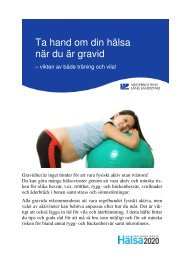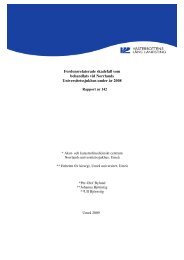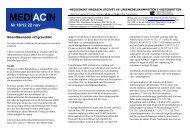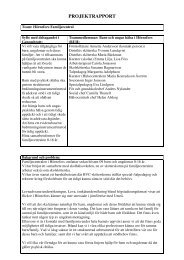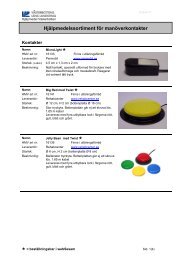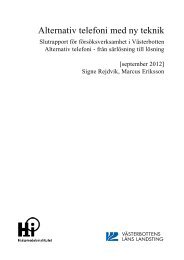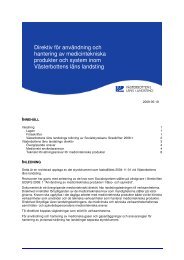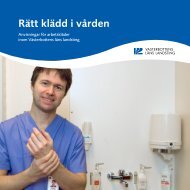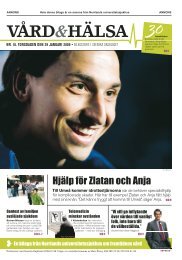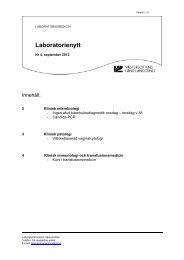An interventional approach to increase the intake of fruits and ...
An interventional approach to increase the intake of fruits and ...
An interventional approach to increase the intake of fruits and ...
Create successful ePaper yourself
Turn your PDF publications into a flip-book with our unique Google optimized e-Paper software.
1. Introduction<br />
The Salut programme is an initiative <strong>of</strong> <strong>the</strong> County Council <strong>of</strong> Västerbotten <strong>to</strong> promote wellbeing<br />
<strong>and</strong> health among all children in <strong>the</strong> county <strong>of</strong> Västerbotten, <strong>and</strong> <strong>the</strong>reby also promote a<br />
healthier future adult population (1). The target <strong>of</strong> Salut is that “by 2020, <strong>the</strong> health <strong>and</strong> wellbeing<br />
<strong>of</strong> <strong>the</strong> population <strong>of</strong> Västerbotten will be <strong>the</strong> best in <strong>the</strong> world”, according <strong>to</strong> <strong>the</strong> vision<br />
<strong>of</strong> <strong>the</strong> County Council. They try <strong>to</strong> achieve this by supporting <strong>the</strong> child <strong>and</strong> its parents during<br />
its entire childhood, starting already during <strong>the</strong> mo<strong>the</strong>r’s pregnancy (2). One <strong>of</strong> <strong>the</strong> domains<br />
<strong>of</strong> <strong>the</strong> programme is <strong>to</strong> improve good eating habits (1).<br />
It is important <strong>to</strong> eat enough <strong>fruits</strong> en vegetables (FV) every day because <strong>of</strong> <strong>the</strong> health<br />
benefits. FV improve <strong>the</strong> sodium/potassium balance which is important <strong>to</strong> keep a healthy<br />
blood pressure. Fibres in FV contribute <strong>to</strong> a good bowel function (3). Eating 600 g FV per day<br />
is estimated <strong>to</strong> result in a decrease <strong>of</strong> 10-20% <strong>of</strong> <strong>the</strong> incidence <strong>of</strong> cardiovascular disease <strong>and</strong><br />
eating at least 400 g/d can result in a decrease in <strong>the</strong> cancer incidence in Sweden (4).<br />
The bachelor <strong>the</strong>sis ´Fruit <strong>and</strong> vegetable <strong>intake</strong> in relation <strong>to</strong> health-related <strong>and</strong> socioeconomic<br />
characteristics among parents-<strong>to</strong>-be in Västerbotten, Sweden´ concludes that <strong>the</strong><br />
majority <strong>of</strong> <strong>the</strong> parents-<strong>to</strong>-be in Västerbotten had an <strong>intake</strong> <strong>of</strong> FV below <strong>the</strong> recommendation<br />
(5). The recommendation for FV <strong>of</strong> <strong>the</strong> Swedish National Food Agency (SLV) is 500<br />
grams/day (6). For example <strong>the</strong>y say <strong>to</strong> eat three portions <strong>fruits</strong> <strong>and</strong> two portions vegetables<br />
each day. Therefore, an amount <strong>of</strong> five portions (<strong>of</strong> 100 grams at a time) per day for FV was<br />
selected as recommendation. Of <strong>the</strong> mo<strong>the</strong>rs-<strong>to</strong>-be 30.4% ate according <strong>the</strong> recommendation<br />
for vegetables <strong>and</strong> 12.1% according <strong>the</strong> recommendation for <strong>fruits</strong>. The median for vegetables<br />
was 5 times/week <strong>and</strong> 4 times/week for <strong>fruits</strong>. The mode for both <strong>fruits</strong> (25.8%) <strong>and</strong><br />
vegetables (26.8%) was 2 times/day. The recommendation was met by 14.7% for vegetables<br />
<strong>and</strong> 12.9% for <strong>fruits</strong> by <strong>the</strong> fa<strong>the</strong>rs-<strong>to</strong>-be. The median for vegetables was 1 time/week <strong>and</strong> 4<br />
times/week for <strong>fruits</strong>. The mode for both <strong>fruits</strong> (19.8%) <strong>and</strong> vegetables (23.5%) was one<br />
time/day. In <strong>to</strong>tal, up <strong>to</strong> 23.5% <strong>of</strong> <strong>the</strong> mo<strong>the</strong>rs-<strong>to</strong>-be <strong>and</strong> 6.9% <strong>of</strong> <strong>the</strong> fa<strong>the</strong>rs-<strong>to</strong>-be met <strong>the</strong><br />
recommendation.<br />
The <strong>intake</strong> <strong>of</strong> both FV was positively associated with physical activity, level <strong>of</strong> education <strong>and</strong><br />
satisfaction with economic situation. Parents-<strong>to</strong>-be with a higher FV <strong>intake</strong> were less likely <strong>to</strong><br />
consider any obstacle when it comes <strong>to</strong> eating nutritious <strong>and</strong> healthy foods. The biggest<br />
considered obstacles were ‘lack <strong>of</strong> time’, ‘irregular working hours’, ‘takes <strong>to</strong>o long <strong>to</strong> cook’<br />
<strong>and</strong> ‘<strong>the</strong> price <strong>of</strong> healthy foods’. These fac<strong>to</strong>rs can be described as ‘barriers’ according <strong>to</strong> <strong>the</strong><br />
‘I-change-model’ (7). O<strong>the</strong>r obstacles were ‘must give up food I like’, ‘healthy food is<br />
dull/less tempting’ (both attitude), ‘family’s or friends’ choices’ (social influences) <strong>and</strong> ‘not<br />
enough cooking skills’ (self efficacy).<br />
In agreement with one <strong>of</strong> <strong>the</strong> project leaders <strong>of</strong> <strong>the</strong> Salut programme, Magdalena Sundqvist,<br />
contact has been made with <strong>the</strong> open preschool ‘Klossen’ located in Ålidhem, Umeå.<br />
‘Klossen’ receives parents with <strong>the</strong>ir children in <strong>the</strong> age <strong>of</strong> 0-5 years old (8). They can do<br />
different activities during <strong>the</strong> morning hours <strong>of</strong> every weekday like singing, playing or<br />
h<strong>and</strong>icraft. Parents can bring <strong>the</strong>ir own food <strong>and</strong> use <strong>the</strong> available kitchen. Fruits, vegetables<br />
<strong>and</strong> o<strong>the</strong>r foods like bread are provided by <strong>the</strong> employees <strong>of</strong> <strong>the</strong> open preschool against<br />
payment. In an <strong>intake</strong> interview with two facilita<strong>to</strong>rs <strong>of</strong> ‘Klossen’, Ingela Thyrsén <strong>and</strong> Brita<br />
Jonsson, possibilities for an intervention were discussed. This report describes <strong>the</strong> <strong>the</strong>ories<br />
behind <strong>the</strong> intervention, which is described in <strong>the</strong> booklet ‘Fruits <strong>and</strong> vegetables at open<br />
preschool ’Klossen’ in Ålidhem’.<br />
5




